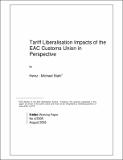Tariff Liberalisation Impacts of the EAC Customs Union in Perspective
View/
Author
Date
2005-08Type
Working Paperviews
downloads
Metadata
Show full item record
Abstract/
This paper analyses the impacts of the EAC Customs Union (CU) Protocol which entered into force on 1 January 2005, after its ratification by the EAC Partner States – Kenya, Tanzania and Uganda. The EAC common external tariff took effect on 1 January 2005; at the same date, tariffs on intra-EAC trade were partially liberalised and will be fully eliminated by end 2009. The analysis of the impacts of EAC CET and intra-EAC tariff liberalisation reveals that the CET effects strongly dominate. Impacts of intra-EAC tariff liberalisation and associated welfare effects of EAC regional integration will, therefore, be relatively small. The relevance of non-tariff barriers (NTBs) to EAC trade and EAC’s strategies to eliminate them are analysed. NTBs are considered clearly more critical obstacles to enhance EAC trade, than tariffs. Policies to address them effectively are considered a prerequisite to reap EAC-CU welfare gains. The paper concludes that EAC CU benefits will not be evenly distributed among EAC Partner States. It recommends EAC should implement compensatory policies to address, in particular, supply constraints and infrastructure bottlenecks in the Partner States less benefited by the CU to ensure the stability of the Community.
Notes
Pgs. 42, with tables. includes footnoted and bibliographic references
Is Part of Series
tralac working paper;No.4/2005Permalink
http://hdl.handle.net/11671/24254Collections
- Articles [132]

